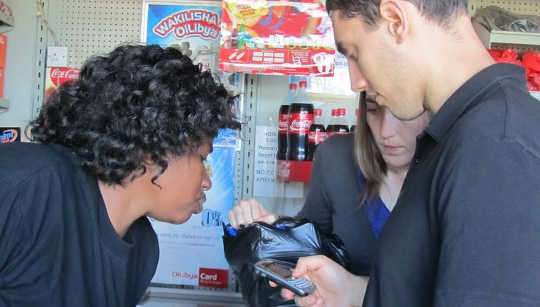
Last week Toby Porter, CEO of the NGO HelpAge, went to Nepal to meet with people recovering from the earthquakes that have devastated the country. He asked them an interesting question: would you rather we buy you the stuff you need, or would you rather we just give you the money?
It’s a question worth asking – and one posed not often enough.
{youtube}-8H1uz8Wq_I{/youtube}
Humanitarian Orthodoxy
Historically, the orthodox approach to helping people in humanitarian emergencies has been to give them things – food, water, hygienic supplies and so on. There’s an argument for this approach, but also a very real risk: that we give people the wrong things. And the network of contractors and subcontractors often used to administer this “in-kind” aid is sufficiently complex and opaque that we can’t really tell how we’re performing.
Take the response to the last earthquake to rock a developing country, in Haiti in 2010. In the wake of that quake, governments and private donors around the world disbursed more than US$9 billion in relief and reconstruction funding. That’s a massive amount of money – about 133% of Haiti’s annual GDP, or more than $900 per resident at the time of the quakes. And yet we have next to no idea whether we bought the right things or what impact they had.
Media investigations have found egregious examples of misplaced spending and inefficiency, including the memorable public health campaign run to teach hand-washing to Haitians who lacked soap and running water.
{youtube}BNM4kEUEcp8{/youtube}
But it’s hard to tell how representative these are, since, for most of the money, we simply don’t know how it was used, as shown by the Center for Global Development, an independent think tank. We can at best take it on faith that we created $900 of value for each citizen of Haiti.
One alternative would have been to simply give $900 to every Haitian. Sound farfetched? As it turns out, this actually requires less faith than many of the more traditional approaches.
Direct Giving Works
As researchers have begun conducting rigorous experimental tests of anti-poverty strategies (“randomized controlled trials”), seeking reliable answers to the question “what works?,” a consistent finding has been that simply giving money directly to individuals works quite well.
Multiple studies have found that when people in need receive cash and the freedom to spend it as they choose, the results are impressive. For example, a study by Christopher Blattman, Nathan Fiala and Sebastian Martinez in post-conflict Uganda found that people who received cash grants invested in enterprises, earning an average 40% rate of return after four years. In post-tsunami Sri Lanka, Suresh de Mel, David McKenzie and Christopher Woodruff found that cash grant recipients saw rates of return in the 80%-plus range after five years.
In addition to improving the long-run living standards of individual recipients, giving aid as cash has the potential to massively streamline delivery. As we’ve explained with Blattman, delivering physical goods to people in need tends to be very expensive (when we know costs at all, which is too infrequent).
For example, a recent Science paper on the (positive) impacts of six programs that transferred assets to the poor found that on average, 68% of program budgets were spent on management and delivery, with only 32% spent on the assets the poor actually received.
The simpler cash-only program run by GiveDirectly (which we co-founded) spends 10% on delivery and puts 90% into recipients’ hands. In other words, we can deliver three times as much value when we deliver as cash. It’s possible that the added management activity involved in the traditional programs offsets this by tripling their value, but we would argue that the burden of proof lies on that side.
Enabling Individuals
Of course, giving cash directly to victims is not the answer to all post-disaster problems. Infrastructure – roads, airports, schools – all needs to be rebuilt, and that requires coordinated activity. But when it comes to helping individuals rebuild their lives, it is hard to see the rationale for giving victims the things we think they might need, instead of enabling them to buy exactly what they want. There is certainly no evidence to suggest we’re better at it than they are.
Will the old ways change? There are glimmers in the response to Nepal. Some aid organizations like HelpAge are already sending cash payments directly to vulnerable individuals, with (anecdotally) positive results. Recipients report receiving support faster and being better able to obtain the specific things they need.
In Lebanon, the IRC recently released results showing strong positive impacts of cash transfers on Syrian refugees.
But overall, the share of humanitarian relief delivered as cash transfers is estimated at no more than 6%, according to the Overseas Development Institute, a UK think tank on international development and humanitarian issues.
If the aim of relief is to help those in need, we might do well to ask Toby Porter’s question more often.
This article was originally published on The Conversation.
Read the original article.
About The Author
 Paul Niehaus is Associate Professor of Economics at University of California, San Diego. He is co-founder and president of GiveDirectly, currently the top-rated nonprofit by GiveWell and ranked among the 25 most audacious companies (Inc) and 10 most innovative companies in finance (Fast Company). GiveDirectly is a recognized leader in the use of modern technology to transfer funds directly to the extreme poor, and in the use of rigorous scientific methods to document its impact.
Paul Niehaus is Associate Professor of Economics at University of California, San Diego. He is co-founder and president of GiveDirectly, currently the top-rated nonprofit by GiveWell and ranked among the 25 most audacious companies (Inc) and 10 most innovative companies in finance (Fast Company). GiveDirectly is a recognized leader in the use of modern technology to transfer funds directly to the extreme poor, and in the use of rigorous scientific methods to document its impact.
Related Book:
at InnerSelf Market and Amazon























